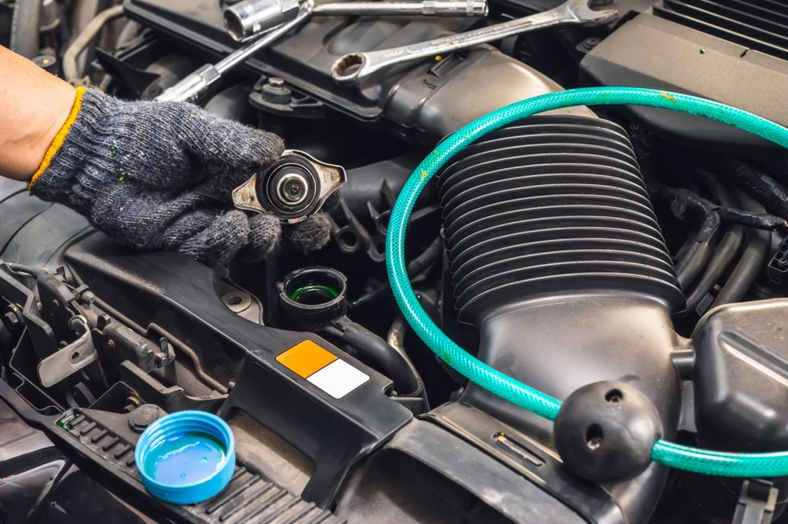Repair instructions
How to Clean a Radiator
Introduction
Keeping your radiator clean is crucial for the efficient operation of your vehicle’s cooling system. A dirty or clogged radiator can cause your engine to overheat and put unnecessary strain on your car. In this guide, I’ll walk you through the correct procedure for both cleaning the external fins and performing a radiator flush, two essential maintenance tasks to keep your cooling system in top shape.
How to Clean Your Radiator
Cleaning your radiator involves two main processes: cleaning the radiator fins and flushing the cooling system. Each is important for maintaining proper airflow and fluid circulation, which are key to preventing overheating.
1. Cleaning the Radiator Fins (External Cleaning)
The fins of the radiator can accumulate dirt, bugs, and debris, obstructing airflow and reducing the efficiency of the cooling system. Regular cleaning ensures the radiator can perform optimally, keeping your engine cool under pressure.

Steps:
- Cool the Engine:
Before starting any work, allow the radiator to cool completely to prevent burns or damage. - Prepare the Cleaning Solution:
Use a radiator fin cleaner or a gentle cleaning solution diluted with water. Check the cleaner’s instructions for the correct dilution ratio. - Apply the Solution:
Pour the diluted cleaner into a spray bottle. Apply the solution liberally to the radiator fins, making sure it covers all visible surfaces. - Scrub the Fins:
Using a soft-bristled brush, gently scrub the radiator fins to dislodge dirt, bugs, and other debris. Be careful not to bend the fins out of shape during cleaning. - Straighten Bent Fins:
If you notice any fins are bent, carefully straighten them with a flathead screwdriver or a similar tool. A thin object like a barbecue skewer can also help reshape the fins without causing damage. - Rinse the Radiator:
Once the fins are clean, use a low-pressure hose to rinse the radiator. Allow the water to flow through the fins from the back to the front, ensuring that all debris is flushed out. - Dry the Radiator:
Let the radiator air dry completely before reassembling or starting the vehicle.
2. Flushing the Radiator (Internal Cleaning)
Flushing the radiator and cooling system removes old coolant, rust, scale, and contaminants that can build up over time. A clean system ensures the coolant circulates efficiently, preventing overheating and corrosion.
Steps:
- Cool the Engine:
Never attempt to flush the radiator when the engine is hot. Ensure the engine has cooled completely before beginning. - Lift the Vehicle:
Use a jack and jack stands to raise the vehicle. Secure the rear wheels with chocks and set the parking brake. - Drain the Coolant:
Place a catch pan under the radiator’s petcock valve (drain valve). Open the valve to drain the old coolant. Dispose of the coolant properly. - Add Flush Solution:
Follow the manufacturer’s instructions for the correct flush product and dilution. Add the flush solution to the radiator, and top off with distilled water. Run the engine with the heater on high for 10–15 minutes to circulate the flush solution through the system. - Drain the Flush Solution:
Once the engine has run for the recommended time, shut it off and let it cool. Drain the flush solution from the radiator. - Flush with Water:
Close the petcock valve and run distilled water through the radiator, repeating the process until the water runs clear. This helps remove any remaining flush solution and contaminants. - Lower the Vehicle:
After the flushing process is complete, lower the vehicle carefully. - Refill with Coolant:
Refill the radiator with the correct type of pre-diluted coolant (typically a 50/50 mixture of coolant and water). Make sure to check your owner’s manual for the specific coolant required for your vehicle. - Check for Leaks:
Start the engine and let it run. Monitor the temperature gauge and coolant levels. If the engine begins to overheat, it could be due to low coolant levels or trapped air in the system. Follow the manufacturer’s procedure to bleed the air from the system if necessary.
How Often Should You Flush Your Radiator?
Flushing your radiator depends on the type of coolant used and the manufacturer’s recommendations. For traditional green antifreeze (inorganic additive technology), a flush every two years or 50,000 miles is typical. For newer organic acid technology coolants, the interval may be longer—every five years or 150,000 miles.
Always refer to your owner’s manual for the precise maintenance schedule for your vehicle.
Benefits of Flushing Your Radiator
- Clears Rust and Scale Build-Up: Flushing removes rust, scale, and other deposits that can clog the radiator and cause overheating.
- Prevents Contaminants from Accumulating: Old coolant can contain contaminants that decrease the efficiency of your cooling system. Regular flushing ensures these contaminants are removed.
- Enhances System Performance: A clean radiator helps the engine maintain an optimal temperature, ensuring the overall health of the vehicle.
- Prevents Rust and Foam Formation: New coolant contains additives that prevent rust and foam from forming, keeping the cooling system in top condition.
Radiator Maintenance Tips
To keep your radiator in good condition between flushes, follow these simple maintenance tips:
- Top Off Your Coolant Regularly: Ensure your coolant is at the proper level and maintain the correct mixture ratio (50/50 coolant and water).
- Ensure the Radiator Cap is Secure: A tight, properly sealed radiator cap helps maintain the correct pressure in the system and prevents leaks.
- Coordinate Radiator Flushing with Oil Changes: Schedule radiator flushes alongside regular oil changes to help remember when to perform this important maintenance task.
Conclusion
Regular maintenance of your radiator—both cleaning the fins and flushing the system—can prevent serious issues like engine overheating and corrosion. Follow the outlined steps and stick to your vehicle’s recommended maintenance schedule to keep your cooling system functioning properly.
If you prefer to have a professional handle the radiator flush, consider taking your car to a trusted mechanic for a full service.
